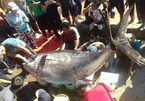according to a national seafood development strategy towards 2030, with a vision forward to 2045.
 |
A report compiled on the implementation of the strategy has recently been sent by the Ministry of Agriculture and Rural Development (MARD) to Prime Minister Nguyen Xuan Phuc for consideration and subsequent approval.
Deputy Minister of Agriculture and Rural Development Phung Duc Tien emphasised that the issuance of the Vietnam Fisheries Development Strategy to 2030, with a vision towards 2045, is essential for the fisheries sector to progress into a fresh stage of development. This will be based on the outstanding achievements recorded during the previous period, in addition to plenty of challenges which are likely to emerge in the new context.
The main target set by 2030 will be the growth rate of aquatic production value of 3.0% to 4.0% annually, while the total output of domestically produced aquatic products will reach 9.8 million tonnes. Of the total, aquaculture output stands at 7.0 million tonnes whilst fishing production volume is at 2.8 million tonnes and seafood export turnover value is between US$14 billion and US$16 billion.
The sector is expected to create jobs for over 3.5 million workers, with their per capita income being equivalent to the average income of workers nationwide.
With a vision towards 2045, the industry will strive to become a modern and commercially sustainable part of the national economy, featuring advanced management, science and technology, while also holding an important position in the structure of agricultural and marine-based economic sectors. This will therefore allow contributions to be made to ensure nutrition and food security, national defence and security, along with sovereignty of the country’s sea and islands.
The MARD has also submitted a report to PM Phuc regarding the approval of a scheme to promote the export of agro-forestry-fishery products until 2030, with the goal of turning the nation into one of the top 10 leading agro-forestry-fishery product processing countries.
The Ministry also emphasised that in terms of the export achievements of the whole country, the agricultural sector has made a great contribution due to being the only sector that continuously maintains a trade surplus.
At present, the nation ranks 16th in the world in terms of export turnover of agro-forestry-fishery products, with rice, fruit and vegetables, coffee, cashew, rubber, wood and wood products, and seafood, including shrimp and catfish, earning an annual export turnover of over US$1 billion.
The export turnover of these items mainly focuses on the commodity groups in some markets such as China, the United States, the EU, and Japan.
The project to promote the export of agro-forestry- fishery products to 2030 can be considered necessary in practice, as it strives to achieve the goals of developing the nation into an exporter of agro-forestry-fishery products that possess high quality in the ASEAN region and around the world. This will thereby secure a firm position in the global supply chain of agriculture, forestry, fisheries, and food.
The country is set to reach approximately US$51 billion in export value of agricultural, forestry and aquatic products by 2025, with roughly 20% of the country's agro-forestry-fishery export products labeled with the national brand. Indeed, 50% of products will be traceable and roughly 50% of the export value of agro- forestry- fishery products will undergo processing and deep processing.
By 2030, the export value of the Vietnamese agro-forestry-fishery industry looks poised to reach approximately US$62 billion, with about 40% of the nation’s agro- forestry- fishery export products bearing the national brand. As such, 70% will be traceable whilst about 60% of the export value of these products will come through processing and deep processing. VOV

Vietnam needs seafood solutions
Vietnam needs to strengthen measures to achieve the sustainable development of seafood exports to the EU market, especially after the EVFTA comes into effect, according to experts.

Vietnam’s tuna exports soar as EVFTA tariff cuts take effect
While many seafood products have seen minus growth because of Covid-19, Vietnam’s tuna has been selling well in the world market.